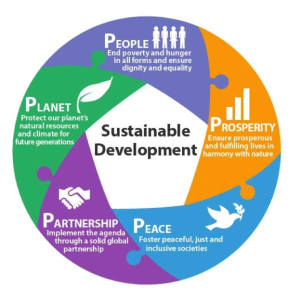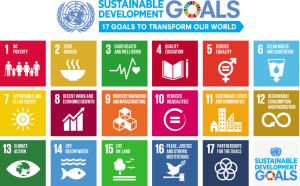Sustainability
A critical part of the SEED model is to incorporate sustainability practices into all elements of the ecosystem if possible. This page provides an overview of several aspects of them
This figure shows an enhanced depiction of the major pillars of sustainability: environmental, social, and economic sustainability; also known as people, planet and prosperity. (Credit: Dr. M. Woersdoerfer)

Small businesses and communities can proactively implement sustainability practices. One study found “that 34% of consumers are willing to pay a premium for sustainable products, with millennials and Gen Z leading the way at 42 and 39% respectively. Although these generations are the youngest consumers, they are also the largest generations, have significant purchasing power, and the importance of their opinions and preferences is only likely to grow.” (Vijayendra, 2023). This infers that embracing sustainable practices is not only ethical, but a good business strategy. Note that the enhanced image of sustainability includes “partnership”, inferring that a collaborative such as our planned ecosystem is an integral part of achieving sustainability.
Here are some examples of sustainable practices:
Environmental (From Green Business Bureau)
- “SWITCH ALL LIGHTING TO LEDS, ONE OF THE EASIEST SUSTAINABLE BUSINESS PRACTICES
- IMPLEMENT A COMPREHENSIVE RECYCLING PROGRAM (including e-waste)
- ALLOW FLEXIBLE WORK-FROM-HOME OPTIONS (reduces emissions) and encourage public transportation and ride sharing.
- ELIMINATE PAPER USE
- INSTALL WATER-SAVING FIXTURES
- CONSIDER RENEWABLE ENERGY (including LED bulbs)
- REPLACE UNNECESSARY BUSINESS TRIPS WITH VIDEO CALLS
Create a local supply chain. This reduces emissions, provides business for local suppliers, and supports the community.
Social
- Pay fair wages for a decent quality of life with decent benefits such as health care
- Corporate culture that focuses on respect, inclusiveness, diversity, ; where everyone feels valued
- Parental leave and child care benefits
- Collaborate with nonprofits
- Affordable healthcare, housing and childcare
Economic
- Sustainable economic growth
- Community investment and collaboration policies
- Green jobs
- Invest a percentage of profits into the environmental and social aspects of the TBL.

Note- we will focus on goals # 8 and 11 in this project.
Green Business Bureau (2021): https://greenbusinessbureau.com/green-practices/20-sustainable-business-practices-for-your-workplace-and-office/
Vijayendra (2023): https://www.allbusiness.com/how-can-small-businesses-be-more-sustainable

